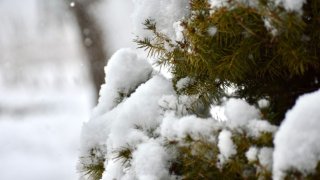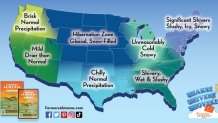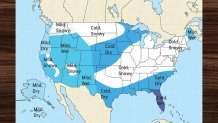
New Englanders have a special affinity for the Almanac – both of them! The Old Farmer’s Almanac is published in Dublin, New Hampshire, with the recognizable yellow cover, while the Farmer’s Almanac and its customary orange color is a product of Lewiston, Maine. Both Almanacs offer an opportunity to thumb through forecasts a couple of days at a time all the way through the upcoming year.
As a child, I used to save up my allowance to scoop up a copy of one or both of the Almanacs and, being a February birthday and a weather lover, my immediate first stop was my birthday, in hopes of the forecast for a snowstorm. Next was Christmas, with early dreams of a White Christmas and a snowy winter. As an adult and a meteorologist, of course I’ve come to realize these day-to-day forecasts so far in advance are more fodder for conversation, chuckles and whimsical thoughts of outdoor plans in the year ahead, but certainly are fun to review each year. Perhaps more value for readers comes from the articles in both Almanacs, covering topics from gardening to home care, organizational tips for the home, auto care, fun facts about nature and more.
While day-to-day forecasts so far out may be an exercise in fantasy, what about the overall winter seasonal forecast from each of the Almanacs? It’s important to start answering any question of seasonal forecast accuracy with the same disclaimer we offer about our own seasonal forecasts on our First Alert Team: while seasonal forecasts are better than flipping a coin, we’re simply not at the point where the general public should put a lot of stock in them, particularly beyond the next season – you may find some reliability looking at this fall, for instance, but looking to the winter and beyond proves a much taller task.
The big reason for the unpredictability more than one season out hinges upon the high impact of exactly where the jet stream winds establish for the winter. The jet stream is the fast river of air, flowing high in the sky, that steers storm systems and separates cold air to the north from warmer air to the south. As the jet stream wind flows from west to east across the Northern Hemisphere, it occasionally takes dips south, called “troughs,” and bumps north, called “ridges.” The impact of troughs and ridges in the jet stream are incursions of cold and warm air, impacting where heaviest rain and snow swaths develop both in the United States and across the Hemisphere, at large. Because of the impact of the exact position of the jet stream on seasonal forecasts, our First Alert Team at NBC10 Boston, NECN and Telemundo New England waits until late in the fall to offer a winter prediction. That said, there are some clues the Almanacs key in on when making their early and bold predictions.
Get Boston local news, weather forecasts, lifestyle and entertainment stories to your inbox. Sign up for NBC Boston’s newsletters.

Big factors in determining seasonal weather patterns revolve around Atlantic and Pacific Ocean water temperatures. You may have heard of El Nino and La Nina before, patterns relating to ocean water temperature particularly in the Pacific Ocean. The relation to weather is vast amounts of cool or warm air over the oceans – related to ocean water temperature – can impact barometric pressure and steering wind flow over the ocean. One can imagine a large change in the steering wind over a huge expanse like the Pacific Ocean can have implications throughout the Northern Hemisphere as the jet stream winds aloft reconfigure.

This winter, it appears as though a La Niña pattern – cool water in the Pacific near the equator – will be a player in the atmosphere, encouraging milder-than-normal conditions in the Southern United States with drier-than-normal conditions particularly in the South-Central and Southwest U.S., with colder air spilling particularly into the Plains, Midwest and Great Lakes, and a clash of air resulting in an active storm path of mixed snow, ice and rain events across the Northeast. It’s no surprise, therefore, that both the Old Farmer’s Almanac and Farmer’s Almanac reflect almost this exact weather pattern in their predictions! So…there is a science-based approach here, the problem being inherent in any seasonal forecast as alluded to above: there’s no guarantee nature will respond in a metered, measured, textbook way to changes in the ocean and atmosphere.
That said, accurate forecast or not, there’s still something about the art of the Almanacs that makes most New Englanders, including yours truly, stop at the display rack, walk past, then ease slowly back to slip the copy off the shelf and curl up with it at home, hoping for another magical White Christmas, birthday storm or perfect wedding day in the year ahead.




